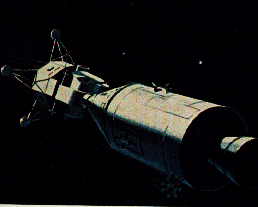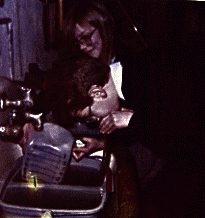KIDS On The Moon :
Wk.5: Lung Capacity Test
Welcome to our Lung Capacity Experiment!

As you can imagine, strong lungs are important to lunar specialists.(*Remember the calculations done on Apollo 13 (*The above shows the Lunar Module, Command, and Service Modules used by all Apollo missions.) regarding oxygen needed and amount of carbon dioxide exhaled?) Most of us inhale oxygen plus other gases, and exhale carbon dioxide (and gases not used) at a constant rate. (Calculating this will help the oxygen-complex system specialists to regulate the oxygen intake and carbon dioxide recycling more efficiently.)
Now, below are the directions for an experiment which roughly tests your oxygen capacity. (*Warning: This is a bit wet, so please use a deep sink area, etc. ) Also, please make this optional so that no student need to try it if he/she doesn't want to.
PROCEDURE:
- Mark a plastic milk container (emptied and cleaned out) from the bottom
(= widest part) in 1 inch increments (not centimeters this time).
(*Use a permanent thick black magic marker to draw 1 inch line increments
and each #)
- Then fill the CLEAN jump sink 80 % to the top with water
and be sure the drain stopper is secured in place.
- Fill the empty milk container with clean water. Then invert it
( WHILE HOLDING THE TOP CLOSED) into the sink with water.
- Get a half inch (diameter) bendable plastic tube (new from the hardware store) that is 3 feet long.
Curve the tube so that one end is inserted about 7 inches into the inverted water container, and the other end can be held by the person getting tested.
- ** Now you're ready to begin: 3 people are needed: a helper, testee, and recorder. Below is a picture of some of our students doing the lung test.

- A helper holds the inverted graduated water container with one end of the tube inserted up about 7 inches.
- Testee (person being tested) holds the opposite end of the tube that's dry and out of the water. (S)He takes a deep breath, then exhales into the tube (as powerfully as (s)he can), sealing the mouthpiece with his/her hands and mouth.
- The recorder makes a list of each person's name, age, and the distance from the water container (that the exhaled air replaced)
(* Ex.The larger the number, the more expelled air was able to empty water out of the container, and the greater one's lung capacity.)
(** Between testees, be sure to wipe the plastic mouth tube with alcohol.
This will insure a purified plastic mouth tube for each testee.
*Teachers, please send a compiled list of
# of STUDENTS , AGE, LUNG CAPACITY #
(*Send your results to dmollica@pilot.njin.net with LungCap.Test in the subject line.
(Results will be posted on ICS's Home Page.)
When all students have completed the tests, gather the information and send us the summary results according to this sample:
Sample Lung Capacity Test
School Name:Immaculate Conception School
Name: ICS Volunteers
Location: Somerville, New Jersey,USA
Age of Students: 15=11 7=12 8=13
Results:
Number of Students: Age Lung Cap. #
13 11 yrs. 5.5
2 10 yrs 8
4 12 yrs 7.8
14 11.5yrs 6.5
Thanks for trying this experiment! We hope you had fun and learned a great deal!
** Please remember to mail in your results to Sister Dianne Mollica

